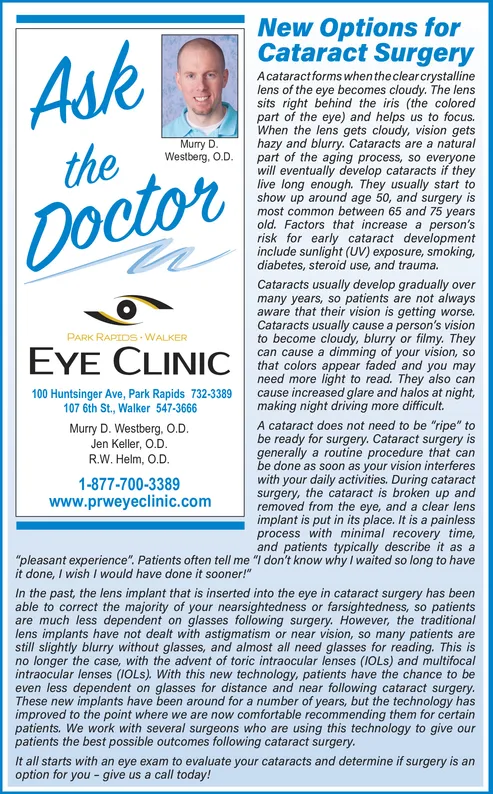Advertisement

-
Published Date
October 5, 2021This ad was originally published on this date and may contain an offer that is no longer valid. To learn more about this business and its most recent offers, click here.
Ad Text
New Options for Cataract Surgery Ask Acataractforms whenthe clear crystalline lens of the eye becomes cloudy. The lens sits right behind the iris (the colored part of the eye) and helps us to focus. When the lens gets cloudy, vision gets hazy and blurry. Cataracts are a natural part of the aging process, so everyone will eventually develop cataracts if they live long enough. They usually start to show up around age 50, and surgery is most common between 65 and 75 years old. Factors that increase a person's risk for early cataract development include sunlight (UV) exposure, smoking, diabetes, steroid use, and trauma. Murry D. Westberg, O.D. the Doctor Cataracts usually develop gradually over many years, so patients are not always aware that their vision is getting worse. Cataracts usually cause a person's vision to become cloudy, blurry or filmy. They can cause a dimming of your vision, so that colors appear faded and you may need more light to read. They also can cause increased glare and halos at night, making night driving more difficult. A cataract does not need to be "ripe" to be ready for surgery. Cataract surgery is generally a routine procedure that can be done as soon as your vision interferes with your daily activities. During cataract surgery, the cataract is broken up and removed from the eye, and a clear lens implant is put in its place. It is a painless process with minimal recovery time, and patients typically describe it as a "pleasant experience". Patients often tell me "I don't know why I waited so long to have PARK RAPIDS WALKER EYE CLINIC 100 Huntsinger Ave, Park Rapids 732-3389 107 6th St., Walker 547-3666 Murry D. Westberg, O.D. Jen Keller, O.D. R.W. Helm, O.D. 1-877-700-3389 www.prweyeclinic.com it done, I wish I would have done it sooner!" In the past, the lens implant that is inserted into the eye in cataract surgery has been able to correct the majority of your nearsightedness or farsightedness, so patients are much less dependent on glasses following surgery. However, the traditional lens implants have not dealt with astigmatism or near vision, so many patients are still slightly blurry without glasses, and almost all need glasses for reading. This is no longer the case, with the advent of toric intraocular lenses (IOLS) and multifocal intraocular lenses (1OLS). With this new technology, patients have the chance to be even less dependent on glasses for distance and near following cataract surgery. These new implants have been around for a number of years, but the technology has improved to the point where we are now comfortable recommending them for certain patients. We work with several surgeons who are using this technology to give our patients the best possible outcomes following cataract surgery. It all starts with an eye exam to evaluate your cataracts and determine if surgery is an option for you - give us a call today! New Options for Cataract Surgery Ask Acataractforms whenthe clear crystalline lens of the eye becomes cloudy. The lens sits right behind the iris (the colored part of the eye) and helps us to focus. When the lens gets cloudy, vision gets hazy and blurry. Cataracts are a natural part of the aging process, so everyone will eventually develop cataracts if they live long enough. They usually start to show up around age 50, and surgery is most common between 65 and 75 years old. Factors that increase a person's risk for early cataract development include sunlight (UV) exposure, smoking, diabetes, steroid use, and trauma. Murry D. Westberg, O.D. the Doctor Cataracts usually develop gradually over many years, so patients are not always aware that their vision is getting worse. Cataracts usually cause a person's vision to become cloudy, blurry or filmy. They can cause a dimming of your vision, so that colors appear faded and you may need more light to read. They also can cause increased glare and halos at night, making night driving more difficult. A cataract does not need to be "ripe" to be ready for surgery. Cataract surgery is generally a routine procedure that can be done as soon as your vision interferes with your daily activities. During cataract surgery, the cataract is broken up and removed from the eye, and a clear lens implant is put in its place. It is a painless process with minimal recovery time, and patients typically describe it as a "pleasant experience". Patients often tell me "I don't know why I waited so long to have PARK RAPIDS WALKER EYE CLINIC 100 Huntsinger Ave, Park Rapids 732-3389 107 6th St., Walker 547-3666 Murry D. Westberg, O.D. Jen Keller, O.D. R.W. Helm, O.D. 1-877-700-3389 www.prweyeclinic.com it done, I wish I would have done it sooner!" In the past, the lens implant that is inserted into the eye in cataract surgery has been able to correct the majority of your nearsightedness or farsightedness, so patients are much less dependent on glasses following surgery. However, the traditional lens implants have not dealt with astigmatism or near vision, so many patients are still slightly blurry without glasses, and almost all need glasses for reading. This is no longer the case, with the advent of toric intraocular lenses (IOLS) and multifocal intraocular lenses (1OLS). With this new technology, patients have the chance to be even less dependent on glasses for distance and near following cataract surgery. These new implants have been around for a number of years, but the technology has improved to the point where we are now comfortable recommending them for certain patients. We work with several surgeons who are using this technology to give our patients the best possible outcomes following cataract surgery. It all starts with an eye exam to evaluate your cataracts and determine if surgery is an option for you - give us a call today!
